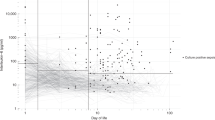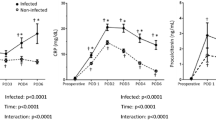Abstract
OBJECTIVE:
To compare the utility of procalcitonin (PCT) vs C-reactive protein (CRP) as indicators of late-onset neonatal sepsis in very low birth weight (VLBW) infants.
METHODS:
PCT and CRP levels were measured in VLBW infants with suspected sepsis and controls. Comparisons were made between infected vs noninfected infants. Using cutoff values of 0.5 and 1.0 ng/ml for PCT and 0.8 mg/dl for CRP, sensitivity, specificity, positive and negative predictive values were calculated to evaluate these assays as potential predictors of late-onset sepsis.
RESULTS:
A total of 67 infants were evaluated. Mean PCT levels were significantly higher in the infected group (5.41 ng/ml) compared to the noninfected group (0.43 ng/ml) (p<0.001). At a cut off value of 0.5 ng/ml, the sensitivity of PCT was 97%, whereas that of CRP was 73% in predicting late-onset sepsis. At a PCT cutoff of 1.0 ng/ml, sensitivities of PCT and CRP were similar (72% each).
CONCLUSION:
PCT (0.5 ng/ml) is more sensitive than CRP in predicting late-onset sepsis in VLBW infants.
This is a preview of subscription content, access via your institution
Access options
Subscribe to this journal
Receive 12 print issues and online access
$259.00 per year
only $21.58 per issue
Buy this article
- Purchase on Springer Link
- Instant access to full article PDF
Prices may be subject to local taxes which are calculated during checkout
Similar content being viewed by others
References
Kochanek KD, Smith BL . Deaths: Preliminary Data for 2002. National Vital Statistics Reports. Vol 52, No. 13. Hyattsville, Maryland: National Center for Health Statistics; 2004.
Fanaroff AA, Korones SB, Wright LL, et al. Incidence, presenting features, risk factors and significance of late onset septicemia in very low birth weight infants. Pediatr Infect Dis 1998;17:593–598.
Sabel KG, Wadsworth CH . C-reactive protein (CRP) in early diagnosis of neonatal septicemia. Acta Paediatr Scand 1979;68:825–831.
Shine B, Gould J, Campbell C . Serum C-reactive protein in normal and infected neonates. Clin Chim Acta 1985;148:97–103.
Forest JC, Lariviere F, Dalce P . C-reactive protein as biochemical indicator of bacterial infection in neonates. Clin Biochem 1986;19:192–194.
Ainbender E, Cabatu EE, Guzman DM, et al. Serum C-reactive protein and problems of newborn infants. J Pediatr 1982;101:438–440.
Pourcyrous M, Bada HS, Korones SB, et al. Acute phase reactants in neonatal bacterial infection. J Perinatol 1991;11:319–325.
Pourcyrous M, Bada HS, Korones SB, et al. Significance of serial C-reactive protein responses in neonatal infection and other disorders. Pediatrics 1993;92:431–435.
Schouten-Van Meeteren NYN, Rietveld A, Moolenaar AJ, et al. Influence of perinatal conditions on C-reactive protein production. J Pediatr 1992;120:621–624.
Gendrel D, Assicot M, Raymond J, et al. Procalcitonin as a marker for the early diagnosis of neonatal infection. J Pediatr 1996;128:570–573.
Assicot M, Gendrel D, Carsin H, Raymond J, Guilbaud J, Bohuon C . High serum procalcitonin concentration in patients with sepsis and infection. Lancet 1993;341:515–518.
Monneret G, Labaune JM, Issac C, Bienvenu F, Putet G, Bienvenu J . Procalcitonin and C-reactive protein levels in neonatal infections. Acta Paediatr 1997;86:209–212.
Al-Nawas B, Krammer I, Shah PM . Procalcitonin in diagnosis of severe infections. Eur J Med Res 1996;1:331–333.
Gendrel D, Bohuon C . Procalcitonin, a marker of bacterial infection. Infection 1997;25:133–134.
Gendrel D, Raymond J, Assicot M, et al. Measurement of procalcitonin levels in children with bacterial or viral meningitis. Clin Infect Dis 1997;24:1240–1242.
Monneret G, Doche C, Durand DV, Lepape A, Bienvenu J . Procalcitonin as a specific marker of bacterial infection in adults. Clin Chem Lab Med 1998;36:67–68.
Chiesa C, Panero A, Rossi N, et al. Reliability of procalcitonin concentrations for the diagnosis of sepsis in critically ill neonates. Clin Infect Dis 1998;26:664–672.
Le Moullec JM, Jullienne A, Chenais J, et al. The complete sequence of human preprocalcitonin. FEBS 1984;167:93–97.
Dandona P, Nix D, Wilson MF, et al. Procalcitonin increase after endotoxin injection in normal subjects. J Clin Endocrinol Metab 1994;79:1605–1608.
Harris MC, Costarino AT, Sullivan JS, et al. Cytokine elevations in critically ill infants with sepsis and necrotizing enterocolitis. J Pediatr 1994;124:105–111.
Franz AR, Kron M, Pohlandt F, Steinbach G . Comparison of procalcitonin with interleukin 8, C-reactive protein and differential white blood cell count for the early diagnosis of bacterial infections in newborn infants. Pediatr Infect Dis J 1999;18:666–671.
Chan YL, Tseng CP, Tsay PK, Chang SS, Chiu TF, Chen JC . Procalcitonin as a marker of bacterial infection in the emergency department: an observational study. Critcal Care 2004;8:R12–R20.
Hausfater P, Garric S, Ayed SB, Rosenheim M, Bernard M, Riou B . Usefulness of procalcitonin as a marker of systemic infection in emergency department patients: a prospective study. Clin Infect Dis 2002;34:895–901.
Weinberg GA, Powell KR . Laboratory aids for diagnosis of neonatal sepsis. In: Remington JS, Klein JO, editors. Infectious Diseases of the Fetus and Newborn Infant. Philadelphia, PA: Saunders; 2001. p. 1327–1344.
Meisner M, Tschaikowsky K, Palmaers T, Schmidt J . Comparison of procalcitonin (PCT) and C-reactive protein (CRP) plasma concentrations at different SOFA scores during the course of sepsis and MODS. Crit Care 1999;3 (1):45–50.
Lapillonne A, Basson E, Monneret G, Bienvenu J, Salle BL . Lack of specificity of procalcitonin for sepsis diagnosis in premature infants. Lancet 1998;351:1211–1212.
Monneret G, Labaune JM, Isaac C, Bienvenu F, Putet G, Bienvenu J . Procalcitonin and C-reactive protein levels in neonatal infections. Acta Paediatr 1997;86:209–212.
Acknowledgements
This study was supported by grants from the Advocate Lutheran General Health Partners Endowment Fund and Advocate Investigator Initiated Research Grant. Special thanks to Bryan Coyle, MA (Statistics).
Author information
Authors and Affiliations
Additional information
E.P.R is currently practicing with Sheridan Health Corporation, Sunrise, FL, USA.
Statistical Consultant: Bryan Coyle, MA of Advocate Institutional Review Board.
Financial Support: Advocate Lutheran General Health Partners Endowment Fund.
Presented in part at the Pediatric Academic Society's Annual Meeting, May, 2004, San Francisco, CA, USA.
Rights and permissions
About this article
Cite this article
Vazzalwar, R., Pina-Rodrigues, E., Puppala, B. et al. Procalcitonin as a Screening Test for Late-Onset Sepsis in Preterm Very Low Birth Weight Infants. J Perinatol 25, 397–402 (2005). https://doi.org/10.1038/sj.jp.7211296
Published:
Issue Date:
DOI: https://doi.org/10.1038/sj.jp.7211296
This article is cited by
-
Markers of platelet activation foR identification of late onset sEpsis in infaNTs: PARENT study protocol
Pediatric Research (2023)
-
Procalcitonin versus C-reactive protein: review of kinetics and performance for diagnosis of neonatal sepsis
Journal of Perinatology (2019)
-
Accuracy of serum procalcitonin for the diagnosis of sepsis in neonates and children with systemic inflammatory syndrome: a meta-analysis
BMC Infectious Diseases (2017)
-
Procalcitonin as an early diagnostic and monitoring tool in urosepsis following percutaneous nephrolithotomy
Urolithiasis (2015)
-
A new procalcitonin cord-based algorithm in early-onset neonatal infection: for a change of paradigm
European Journal of Clinical Microbiology & Infectious Diseases (2014)



